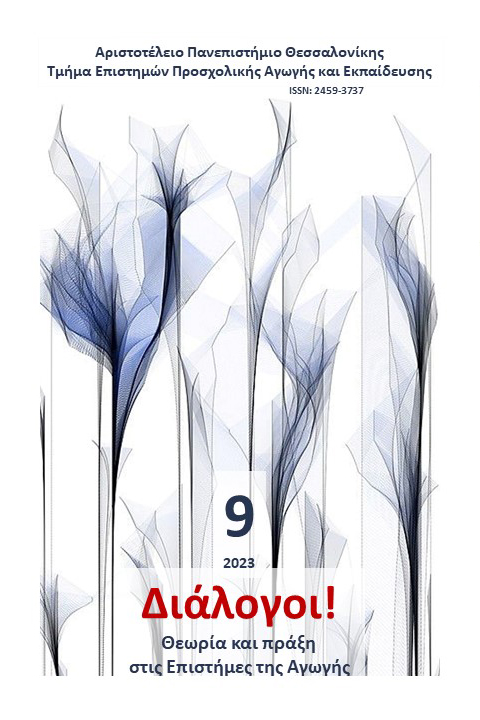A case study on preschool children’s preferences of and perspectives on their male and female early childhood educator

Περίληψη
Σκοπός της μελέτης: Η παρούσα μελέτη περίπτωσης είχε ως στόχο τη διερεύνηση των προοπτικών των παιδιών προσχολικής ηλικίας σχετικά με το εάν και πώς το φύλο των παιδαγωγών διαμορφώνει τον τρόπο που βλέπουν τον παιδαγωγικό ρόλο των παιδαγωγών τους και τον βαθμό στον οποίο τα παιδιά δείχνουν προτίμηση σε κάποιον από τους παιδαγωγούς τους με βάση το φύλο τους. Διερευνήθηκαν, επίσης, ομοιότητες και διαφορές μεταξύ των αντιλήψεων των αγοριών και των κοριτσιών για τον ρόλο των παιδαγωγών τους. Από την άλλη πλευρά, η μελέτη είχε ως στόχο να διερευνήσει εάν τα παιδιά εκδηλώνουν διαφορετική στάση απέναντι στους παιδαγωγούς τους όταν είναι στο σπίτι. Μέθοδος: Συλλέχθηκαν δεδομένα από οκτώ παιδιά προσχολικής ηλικίας μέσω παιδικών ζωγραφιών, φωτογραφιών και συνεντεύξεων με τα παιδιά. Επίσης, πέντε γονείς συμπλήρωσαν ένα διαδικτυακό ερωτηματολόγιο με ερωτήσεις ανοιχτού τύπου. Αποτελέσματα & Συμπεράσματα: Τα αποτελέσματα δείχνουν ότι τα παιδιά αποδίδουν έναν παιγνιδιώδη ρόλο στον άνδρα παιδαγωγό και έναν εκπαιδευτικό ρόλο στη γυναίκα παιδαγωγό. Τα δεδομένα που προέκυψαν τόσο από τα παιδιά όσο και από τους γονείς δείχνουν ότι η ύπαρξη ενός άνδρα παιδαγωγού ικανοποιεί την επιθυμία ή την ανάγκη των παιδιών, και ιδιαίτερα των αγοριών, για μια ανδρική φιγούρα στον θηλυκοποιημένο τομέα της προσχολικής αγωγής και φροντίδας. Επιπλέον, τα αποτελέσματα αναδεικνύουν την ανάγκη να ακούγονται οι φωνές των παιδιών για όλα τα ζητήματα που τα αφορούν, καθώς και να υιοθετούνται ποικίλες μέθοδοι για τη δημιουργία διαφοροποιημένων προοπτικών.
Λεπτομέρειες άρθρου
- Πώς να δημιουργήσετε Αναφορές
-
Rentzou, K. (2023). A case study on preschool children’s preferences of and perspectives on their male and female early childhood educator. Διάλογοι! Θεωρία και πράξη στις επιστήμες αγωγής και εκπαίδευσης, 9, 47–68. https://doi.org/10.12681/dial.36278
- Τεύχος
- Τόμ. 9 (2023)
- Ενότητα
- Επιστημονική Αρθογραφία

Αυτή η εργασία είναι αδειοδοτημένη υπό το CC Αναφορά Δημιουργού – Μη Εμπορική Χρήση – Παρόμοια Διανομή 4.0.
Οι συγγραφείς των άρθρων που δημοσιεύονται στο Διάλογοι! Θεωρία και Πράξη στις Επιστήμες Αγωγής και Εκπαίδευσης διατηρούν τα δικαιώματα πνευματικής ιδιοκτησίας επί των άρθρων τους, δίνοντας στο περιοδικό το δικαίωμα της πρώτης δημοσίευσης. Άρθρα που δημοσιεύονται στο Διάλογοι! Θεωρία και Πράξη στις Επιστήμες της Αγωγής και Εκπαίδευσης διατίθενται με άδεια Creative Commons 4.0 και σύμφωνα με την άδεια μπορούν να χρησιμοποιούνται ελεύθερα, με αναφορά στον/στη συγγραφέα και στην πρώτη δημοσίευση για μη κερδοσκοπικούς σκοπούς και με δικαίωμα τροποποίησης μόνον με παρόμοια διανομή (αν αναμείξετε, τροποποιήσετε, ή δημιουργήσετε πάνω στο υλικό, πρέπει να διανείμετε τις δικές σας συνεισφορές υπό την ίδια άδεια όπως και το πρωτότυπο).
To Τμήμα Επιστημών Προσχολικής Αγωγής και Εκπαίδευσης του Αριστοτέλειου Πανεπιστημίου Θεσσαλονίκης και το Εθνικό Κέντρο Τεκμηρίωσης διατηρούν το δικαίωμα να δημοσιεύουν, να αναπαραγάγουν, να παρουσιάζουν στο κοινό, να διανέμουν και να χρησιμοποιούν άρθρα που δημοσιεύονται στο Διάλογοι! Θεωρία και Πράξη στις Επιστήμες Αγωγής και Εκπαίδευσης σε οποιοδήποτε μέσο και μορφή είτε μεμονωμένα είτε ως μέρη συλλογικών έργων, για όλο το χρόνο διάρκειας προστασίας της πνευματικής ιδιοκτησίας και για όλες τις χώρες του κόσμου.
Αυτό περιλαμβάνει ενδεικτικά, και όχι αποκλειστικά, το δικαίωμα δημοσίευσης των άρθρων σε τεύχη του περιοδικού Διάλογοι! Θεωρία και Πράξη στις Επιστήμες Αγωγής και Εκπαίδευσης, αναπαραγωγής και διανομής μεμονωμένων αντιγράφων των άρθρων, αναπαραγωγής ολόκληρων των άρθρων σε άλλη έκδοση του Τμήματος Επιστημών Προσχολικής Αγωγής και Εκπαίδευσης του Αριστοτέλειου Πανεπιστημίου Θεσσαλονίκης και του Εθνικού Κέντρου Τεκμηρίωσης και αναπαραγωγής και διανομής των άρθρων ή περίληψης αυτών με χρήση πληροφορικού συστήματος αποθετηρίου.


